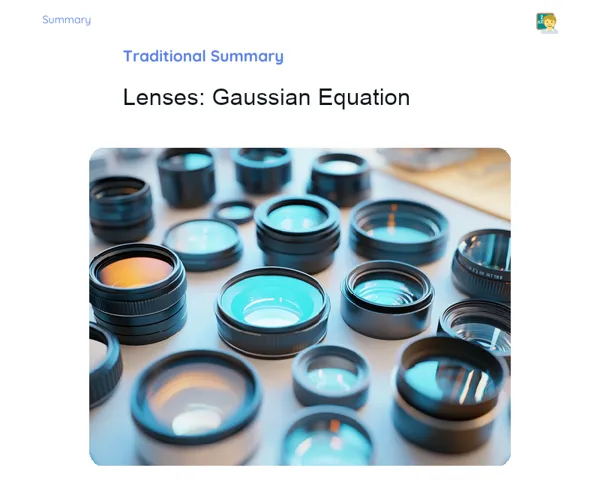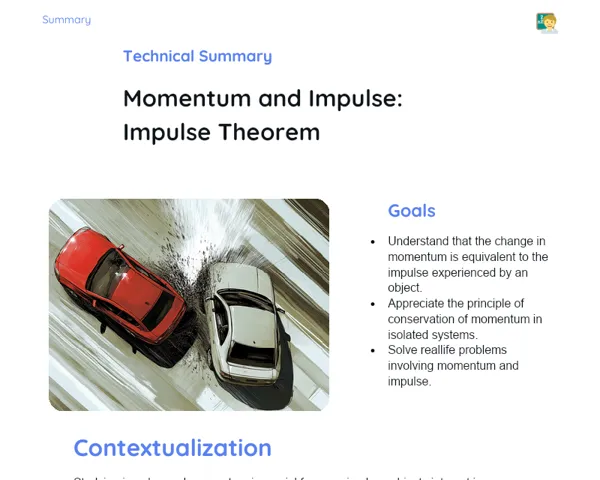Socioemotional Summary Conclusion
Goals
1. 🤔 Understand the concept of Simple Harmonic Motion (SHM) and its underlying principles.
2. 📐 Identify the key characteristics that determine if an object is in SHM.
3. 🔍 Connect the theory of SHM to real-life examples such as pendulums and springs.
4. 🌟 Enhance socioemotional skills like self-regulation and emotional management while navigating academic hurdles.
Contextualization
Have you ever watched an antique clock pendulum swinging rhythmically? This graceful motion isn’t just visually appealing; it perfectly illustrates Simple Harmonic Motion (SHM). SHM can be found in many situations around us, from the tiny oscillations of a spring to the vibrations we hear in sound. Grasping this concept is like uncovering a hidden dance in nature, governed by fascinating physical laws. Let's embark on this journey and explore how these oscillations not only explain various physical phenomena but also guide us towards achieving balance in our own lives.
Exercising Your Knowledge
Definition of Simple Harmonic Motion (SHM)
Simple Harmonic Motion (SHM) refers to a rhythmic type of movement where an object's acceleration is directly proportional to its distance from a rest position, but in the opposite direction. This leads to a continuous back-and-forth motion that follows a sinusoidal pattern. Understanding SHM is crucial for Physics and has various applications in technology and nature.
-
Direct Proportionality: Acceleration relates to displacement; greater displacement results in greater acceleration.
-
Opposite Direction: Acceleration always aims back towards the rest position, defining the oscillation of SHM.
-
Differential Equation: The formula describing SHM is a = -ω²x, where 'a' denotes acceleration, 'ω' is angular frequency, and 'x' stands for displacement.
-
Relation to Emotions: Just like SHM has an equilibrium point, we too possess an emotional balance. Recognizing this is vital for emotional management.
Classic Example - Simple Pendulum
The simple pendulum is one of the clearest representations of SHM. When it is moved from its resting position and released, it swings back and forth. The force that brings it back is proportional to how far it’s been displaced from its original position, continuing until external forces such as air resistance dissipate its energy.
-
Restoring Force: The force returning the pendulum to its rest point is proportional to its displacement (F = -kx).
-
Oscillation Period: The time for a complete swing is constant and can be calculated.
-
Length Dependency: The pendulum's period depends on the string length and gravity (T = 2π√(L/g)).
-
Parallel with Life: Our emotional struggles can be likened to the pendulum – swaying away from balance, yet always striving to return to emotional stability.
Classic Example - Ideal Spring
Another good example of SHM is a spring system. When an object attached to a spring is displaced, the spring exerts a restoring force proportional to this displacement, as outlined by Hooke's Law (F = -kx). This action results in the characteristic oscillatory motion of SHM.
-
Hooke's Law: Outlines the restoring force of the spring, proportional to the object's displacement (F = -kx).
-
Spring Constant: 'k' in Hooke's Law represents the spring constant, indicating its stiffness.
-
Energy in the System: The total energy combines potential elastic energy with kinetic energy, remaining unchanged throughout the motion.
-
Socioemotional Skills: As the spring aims to return to equilibrium, we too must cultivate our abilities to regain emotional balance during challenging moments.
Key Terms
-
Simple Harmonic Motion (SHM): An oscillatory motion where acceleration is directly proportional but opposite in direction to an object's displacement.
-
Differential Equation: A = -ω²x – representing how acceleration (a) correlates to displacement (x) and angular frequency (ω).
-
Hooke's Law: F = -kx – explaining the restoring force from a spring, with 'k' as the spring constant and 'x' indicating displacement.
-
Angular Frequency (ω): A metric for the number of oscillations within a unit time during an SHM cycle.
-
Equilibrium Point: The position where the restoring force acts as zero and the object experiences no acceleration.
For Reflection
-
🎭 How did you feel while engaging with the pendulum and spring during practice? What emotions surfaced, and how did you manage them?
-
🔄 How can we connect the concept of equilibrium in SHM to our own life's journey towards balance? What techniques might we employ to rejuvenate our emotional stability during tough times?
-
🌊 Can you identify other instances in daily life where oscillations similar to SHM happen? How might understanding this concept assist us in handling these situations better?
Important Conclusions
-
🌟 Simple Harmonic Motion (SHM) exemplifies a type of oscillation where acceleration is directly proportional yet opposite to displacement.
-
🔍 Classic representations of SHM, like the simple pendulum and ideal spring, showcase how restoring forces lead to persistent oscillations.
-
📈 The differential equation governing SHM and Hooke's Law are foundational in understanding the interplay between acceleration and displacement.
-
🌐 A grasp of SHM enables us to identify and analyze multiple natural and man-made systems, while providing insightful parallels for maintaining emotional equilibrium.
Impacts on Society
Simple Harmonic Motion (SHM) has a wide range of practical uses in daily life. Devices we frequently rely on, such as clocks, vehicle suspension systems, and certain sensors, function according to SHM principles. Familiarity with these concepts can inspire us to innovate and enhance technologies that improve comfort and safety in our lives. Furthermore, an understanding of SHM is crucial in fields like civil engineering, where knowledge of oscillations aids in designing structures resilient to earthquakes.
On a personal level, drawing parallels between SHM and our emotional responses can empower us to manage stress and challenges more effectively. Like a pendulum returning to its equilibrium, learning to identify and regulate our emotions can guide us back to a state of harmony. This knowledge enriches our mental wellness and bolsters our interpersonal relationships, allowing for more mindful and balanced decision-making.
Dealing with Emotions
To better handle your emotions while learning about SHM and its applications, try an exercise based on the RULER approach. Start by recognizing the emotions that pop up while grappling with challenging topics, like frustration or curiosity. Next, understand what triggers these feelings, perhaps initial hurdles with the differential equation. Label these emotions correctly – be it frustration, anxiety, or enthusiasm – to grasp exactly what you're experiencing. Then, express your feelings suitably, such as discussing concerns with classmates or teachers. Finally, regulate your emotions through methods like deep breathing or taking short study breaks to maintain clarity and calmness.
Study Tips
-
🎯 Create Visual Summaries: Employ diagrams and charts to visualize the relationship between acceleration and displacement in SHM. This visual aid can reinforce understanding of key concepts.
-
🤔 Study Group: Collaborate with peers to discuss equations and real-world examples. Sharing insights and uncertainties can deepen comprehension.
-
🗣️ Explain to Someone: Attempt explaining SHM and its examples to someone unfamiliar with the topic. This process solidifies your grasp and highlights any gaps in your understanding.



